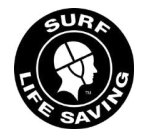The provision of a safe environment at all SLSA competitions is paramount.
Prior to the commencement of any competition the Competition Committee must be satisfied that all competition and non-competition arrangements provide the necessary safety for competitors, officials and other personnel involved at the competition. The Competition Committee must also be satisfied that the surf conditions are satisfactory for competition to proceed. Tests may be undertaken to assist in these assessment processes. An Event Safety Guide Sheet/Tool/Application and Referee Pre-Competition Checklist may be used to assist in the assessment processes (refer to Appendices A and Appendices B for samples or contact SLSA).
Should, at any stage prior to or during competition, there is a credible basis for concluding there is an unreasonable risk of serious injury occurring, officials shall suspend all or parts of the competition. The Competition Committee (refer Section 12), shall then decide whether to postpone, cancel or relocate all or parts of the competition.
In addition, where required, SLSA has the authority to seek assessment of the physical and psychological fitness of any competitor or official and ensure through the Referee to the Competition Committee that an unfit competitor or official does not participate for the wellbeing and safety of themselves and/or others involved in a competition.
Activity participants compete in SLSA competitions to demonstrate their physical and mental skills.
Event officials and organisers conduct competitions to support and encourage competing lifesavers to demonstrate their lifesaving skills and organisational efficiency. Qualified lifesavers and beach support personnel, actively display their prowess as the lifesaving authority in that competition.
At all competitions, the organising group conducting the competition shall provide sufficient and properly equipped and qualified water safety personnel (at each venue) as required by the appropriate lifesaving authority. The provision of rescue craft and a communication network is essential at all competitions. No event shall commence unless a viable means of rescuing an unconscious person from the water is in place, i.e. a crewed Inflatable Rescue Boat (IRB) or crewed Rescue Water Craft (RWC) is on the water and in the competition area. Further, for events involving U13 and under aged unqualified participants (i.e. non SRC Award holders) the requirements of the SLSA Water Safety Policy 1.01 and Procedure shall apply, viz:
- One Water Safety Personnel to five participants; or
- One Water Safety Personnel to 10 participants where low risk conditions are determined by completion of an Event Safety Guide Sheet/Tool/Application.
Note 1: A low risk condition is generally described as surf conditions under one metre, however, other surf and environmental conditions should also be factored into an assessment.
Note 2: The requirement for a crewed IRB or a crewed RWC detailed above counts as two water safety personnel.
If an emergency arises during a competition, effective command and control shall be maintained under the direction of the Safety and Emergency Management Coordinator (SEMC) or the Referee (if a dedicated SEMC is not appointed).
During an emergency, any member of SLSA entering the water or handling any rescue gear must only do so at the direction of the Safety and Emergency Management Coordinator or delegate and/or under the direction of the Police or emergency authority.
All surf life saving members not engaged in actual rescue work should assist in maintaining a clear area so that any rescue attempt can be carried out efficiently.
A log (including written notes, photographs and/or audio or visual recordings where applicable) of responses to all rescues, emergencies or major incidents is to be maintained for reference.
The above directions are mandatory and essential to the safe and orderly conduct of surf life saving competitions.

